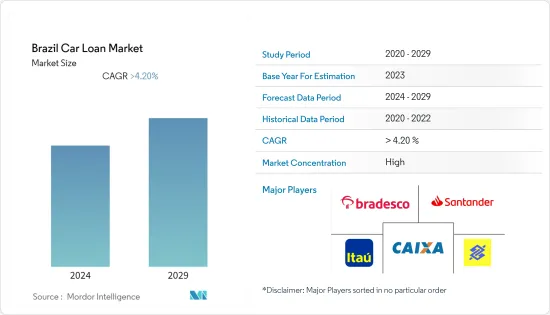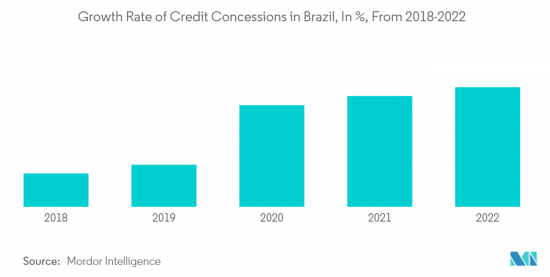PUBLISHER: Mordor Intelligence | PRODUCT CODE: 1408210

PUBLISHER: Mordor Intelligence | PRODUCT CODE: 1408210
Brazil Car Loan - Market Share Analysis, Industry Trends & Statistics, Growth Forecasts 2024 - 2029

The Brazil Car Loan Market generated a revenue of USD 22 billion in the current year and is poised to grow at a CAGR greater than 4.2% during the forecast period.
The car loan market in Brazil is a significant part of the country's financial sector and plays a vital role in the economy. Brazilian consumers often rely on car loans to finance their vehicles, whether buying new or used cars. Several types of car loans are available in Brazil, including traditional loans, leasing, and financing through car dealerships. Banks and financial institutions usually offer traditional loans and leasing options, while automakers or specialized finance companies typically offer financing through car dealerships.
Interest rates on car loans in Brazil can vary widely depending on several factors, such as the borrower's creditworthiness, the type of vehicle being financed, and the loan repayment term. The interest rates can range from around 1.5% to 3.5% per month, depending on the type of loan and the borrower's credit score. The repayment term for car loans in Brazil can range from 12 to 60 months, with some lenders offering even longer terms. However, longer repayment terms can result in higher overall interest costs.
The COVID-19 pandemic significantly impacted the car loan market in Brazil. Like many countries, Brazil experienced economic disruptions and changes in consumer behavior due to lockdown measures and reduced economic activity. During the initial phases of the pandemic, car sales and loan applications declined significantly as people focused on essential spending and were uncertain about their financial situations. It resulted in a temporary slowdown in the car loan market.
Brazil Car Loan Market Trends
Availability and Accessibility of Credit is Driving the Market
The availability and accessibility of credit played a significant role in driving the car loan market in Brazil. Over the years, Brazil witnessed the expansion of financial institutions and the development of credit infrastructure, making it easier for individuals to obtain car loans.
One key factor is the increased competition among banks and other financial institutions. As more players enter the market, they strive to attract customers by offering competitive interest rates, flexible repayment terms, and simplified application processes. This increased competition resulted in more accessible credit options for car loan consumers.
Brazil's growing middle class and rising disposable incomes created a greater demand for personal vehicles. As people aspire to own cars, credit availability provides them with the means to finance their purchases. Car loans allow individuals to spread the cost of buying a car over time, making it more affordable and manageable for a broader population segment.
The Brazilian government also implemented policies to stimulate car sales and support the automotive industry. Tax incentives and subsidized interest rates on car loans further encouraged consumers to purchase vehicles, boosting the demand for car loans.

Rise in Demand for Luxury Cars Fueling the Market Growth
The rise in demand for luxury cars contributed to Brazil's car loan market's growth. As the country's economy improved and the purchasing power of consumers increased, there was a noticeable shift towards luxury vehicles.
Luxury cars are often associated with higher price tags, making them less affordable for many buyers when purchasing outright. Car loans provide a solution by allowing individuals to finance the purchase of these high-end vehicles over time, making them more accessible to a broader range of consumers.
Financial institutions and car dealerships recognized this trend and tailored their offerings to cater to the luxury car market. They developed specialized loan programs and financing options for luxury vehicles, providing competitive interest rates and favorable terms to attract buyers.
Furthermore, luxury cars' allure, advanced features, cutting-edge technology, and prestigious branding fueled consumer aspirations. As more individuals aspire to own these luxury vehicles, the availability of car loans plays a vital role in turning those aspirations into reality.
It's worth noting that the demand for luxury cars is not limited to Brazil's major cities but also spread to emerging markets and regions across the country. This wider geographical reach further contributed to the growth of the car loan market as financial institutions extended their services to cater to the increasing demand.
Brazil Car Loan Industry Overview
The market for Brazilian car loans is highly fragmented. Major players like Banco do Brasil, Caixa Economica Federal, Bradesco, Santander, and Itau Unibanco dominate the market. However, due to product innovation and technology developments, mid-sized and smaller businesses are growing their market share by winning new businesses and entering untapped sectors.
Additional Benefits:
- The market estimate (ME) sheet in Excel format
- 3 months of analyst support
TABLE OF CONTENTS
1 INTRODUCTION
- 1.1 Study Assumptions and Market Definition
- 1.2 Scope of the Study
2 RESEARCH METHODOLOGY
3 EXECUTIVE SUMMARY
4 MARKET INSIGHTS AND DYNAMICS
- 4.1 Market Overview
- 4.2 Market Drivers
- 4.2.1 Availability and Accessibility of Credit is Driving the Market
- 4.2.2 Rise in Demand for Luxury Cars Fueling the Market Growth
- 4.3 Market Restraints
- 4.3.1 Increase in Car Loan Interest Rates is Restraining the Market
- 4.3.2 Changing Mobility Trends is Restraining the Market
- 4.4 Market Opportunities
- 4.4.1 Increasing Popularity of Electric Vehicles (EVs)
- 4.4.2 Collaborations Between Car Manufacturers and Lenders
- 4.5 Industry Attractiveness - Porter's Five Forces Analysis
- 4.5.1 Bargaining Power of Suppliers
- 4.5.2 Bargaining Power of Buyers
- 4.5.3 Threat of New Entrants
- 4.5.4 Threat of Substitutes
- 4.5.5 Intensity of Competitive Rivalry
- 4.6 Insights of Technology Innovations in the Market
- 4.7 Impact of COVID-19 on the Market
5 MARKET SEGMENTATION
- 5.1 By Product Type
- 5.1.1 Used Cars (Consumer Use & Business Use)
- 5.1.2 New Cars (Consumer Use & Business Use)
- 5.2 By Provider Type
- 5.2.1 Banks
- 5.2.2 Non-Banking Financial Services
- 5.2.3 Original Equipment Manufacturers
- 5.2.4 Others (Fintech Companies)
6 COMPETITIVE LANDSCAPE
- 6.1 Market Concentration Overview
- 6.2 Company Profiles
- 6.2.1 Banco do Brasil
- 6.2.2 Caixa Economica Federal
- 6.2.3 Bradesco
- 6.2.4 Santander
- 6.2.5 Itau Unibanco
- 6.2.6 BV Financeira
- 6.2.7 Banco Pan
- 6.2.8 Banco Safra
- 6.2.9 Omni Financeira
- 6.2.10 Crefisa*
7 FUTURE TRENDS
8 DISCLAIMER AND ABOUT US




